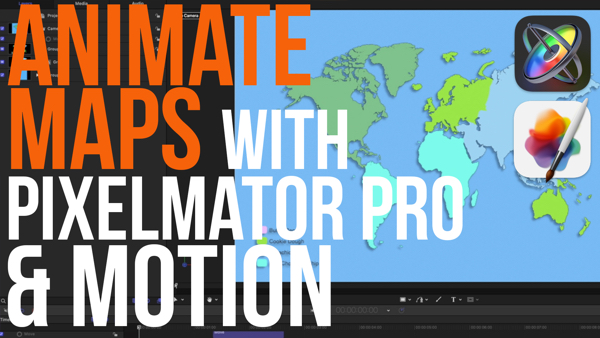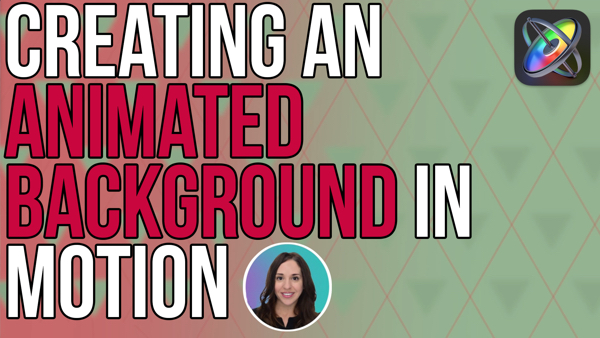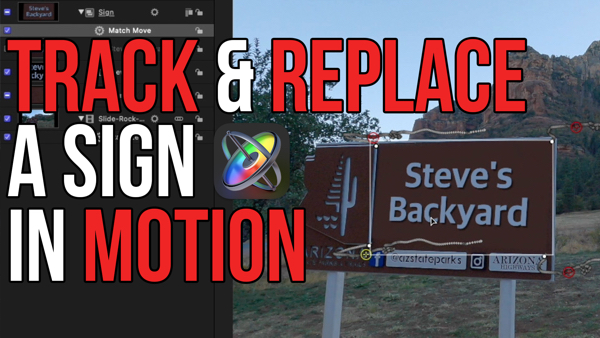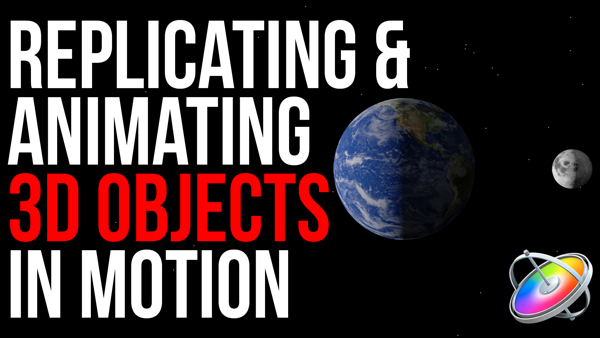How to Create a 3D Text Environment in Motion 5
In episode 25 of Motion Magic in Under 5 Minutes, Mark Spencer will show you how to build an environment for your 3D text using Motion 5.2 that includes realistic floor reflections and shadows cast by scene lighting.
In this episode, I’ll show you how to create an environment for 3D text.
I’m Mark Spencer from RippleTraining.com. Welcome to Motion Magic, where you’ll learn visual effects and motion graphics in under 5 minutes.
Here I am in Motion where I’ve created a 3D text layer. If you don’t already know how to do this, you’ll want to check out our brand new tutorial on creating 3D titles in Motion.
Now I’ll add a camera and use the 3D view tools to take a closer look at this 3D text.
The text is hanging out in empty space; this grid here is just for reference and won’t show in the rendered movie, and I want to put this text inside an environment. So first, I’ll double-click one of the 3D View tools to reset the camera.
Then I’ll go to the Library, to Generators, to the Generators folder, and add the Color Solid to my group in the Layers list. And I’ll press Command-Left Bracket to move it below the text layer.
This color solid will be my floor, so I’ll hold down the Shift key and drag up on the top X-axis rotation handle to tilt the floor down, snapping to exactly 90 degrees.
If I orbit the camera now, we see the text is sitting on our new floor. I’ll press F1 for the Properties Inspector and change the scale to 500%, then I’ll enable Reflections, show the Reflection parameters, enable Falloff, reveal the Falloff parameters, and adjust the End Distance and Exponent.
In the Generator Inspector, I’ll change the color to white.
When I orbit the camera now, the reflections serve to create the illusion that the text is sitting on a shiny floor.
However, the floor is not infinite, and the space above the floor is not white – it looks black, but it’s actually transparent, which you can tell by going to the Channels menu and selecting Transparent.
Let’s return to Color.
To make the background blend with the floor, I’ll select the Project in the Layers list, then in the Properties tab, set the Background Color to white and the Background to Environment. I’ll also go to the View menu to turn off the 3D grid because it’s distracting.
Now we have beautiful textured 3D text on an infinite floor in an infinite white space so we can point the camera anywhere we like, being careful to not go below the floor which will block the reflections.
But how about shadows? Let’s select the text layer and go to the Text Inspector, to the Appearance tab.
The built-in Lighting Styles are great, but they don’t cast shadows. However, Motion’s 3D lights DO cast shadows, and you can use them to replicate these presets.
Notice we are using Diagonal Left. Let’s change that to Off.
Now from the Object menu, I’ll choose New Light Setup > Diagonal Left. Instant shadows!
In the Layers list, a new group appears containing two new lights that you can adjust and animate. I’ll select the Diagonal Left light, rotate it in the Canvas, and adjust its intensity in the Inspector.
If I orbit the camera now, we have 3D text in a full environment with reflections and shadows.
Click the subscribe button below. If you have an idea, comment or suggestion, leave those below as well. Go to RippleTraining.com for fast professional training on Final Cut Pro, Motion and DaVinci Resolve from industry professionals.
I’m Mark Spencer from RippleTraining.com. Welcome to Motion Magic, where you’ll learn visual effects and motion graphics in under 5 minutes.
Here I am in Motion where I’ve created a 3D text layer. If you don’t already know how to do this, you’ll want to check out our brand new tutorial on creating 3D titles in Motion.
Now I’ll add a camera and use the 3D view tools to take a closer look at this 3D text.
The text is hanging out in empty space; this grid here is just for reference and won’t show in the rendered movie, and I want to put this text inside an environment. So first, I’ll double-click one of the 3D View tools to reset the camera.
Then I’ll go to the Library, to Generators, to the Generators folder, and add the Color Solid to my group in the Layers list. And I’ll press Command-Left Bracket to move it below the text layer.
This color solid will be my floor, so I’ll hold down the Shift key and drag up on the top X-axis rotation handle to tilt the floor down, snapping to exactly 90 degrees.
If I orbit the camera now, we see the text is sitting on our new floor. I’ll press F1 for the Properties Inspector and change the scale to 500%, then I’ll enable Reflections, show the Reflection parameters, enable Falloff, reveal the Falloff parameters, and adjust the End Distance and Exponent.
In the Generator Inspector, I’ll change the color to white.
When I orbit the camera now, the reflections serve to create the illusion that the text is sitting on a shiny floor.
However, the floor is not infinite, and the space above the floor is not white – it looks black, but it’s actually transparent, which you can tell by going to the Channels menu and selecting Transparent.
Let’s return to Color.
To make the background blend with the floor, I’ll select the Project in the Layers list, then in the Properties tab, set the Background Color to white and the Background to Environment. I’ll also go to the View menu to turn off the 3D grid because it’s distracting.
Now we have beautiful textured 3D text on an infinite floor in an infinite white space so we can point the camera anywhere we like, being careful to not go below the floor which will block the reflections.
But how about shadows? Let’s select the text layer and go to the Text Inspector, to the Appearance tab.
The built-in Lighting Styles are great, but they don’t cast shadows. However, Motion’s 3D lights DO cast shadows, and you can use them to replicate these presets.
Notice we are using Diagonal Left. Let’s change that to Off.
Now from the Object menu, I’ll choose New Light Setup > Diagonal Left. Instant shadows!
In the Layers list, a new group appears containing two new lights that you can adjust and animate. I’ll select the Diagonal Left light, rotate it in the Canvas, and adjust its intensity in the Inspector.
If I orbit the camera now, we have 3D text in a full environment with reflections and shadows.
Click the subscribe button below. If you have an idea, comment or suggestion, leave those below as well. Go to RippleTraining.com for fast professional training on Final Cut Pro, Motion and DaVinci Resolve from industry professionals.




